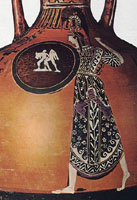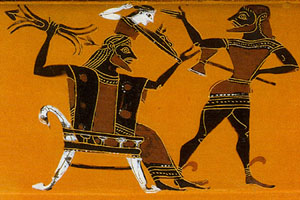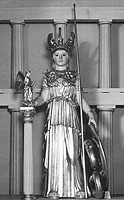Athena (Roman Minerva)



The Greek goddess of war and wisdom. She is usually shown as a warrior with helmet and shield, but also wearing the magic
aigis. She was born from the head of her father
Zeus, a common subject in archaic and classical art (the
Parthenon east pediment). She was the patron goddess of
Athens, where her temples occupied the
Acropolis, but also of other Greek cities. In myth she supports heroes such as
Herakles,
Theseus and
Perseus and actively helped
Achilles and the Greeks during the Trojan War. In this role she is frequently seen attending battle scenes but takes no part, except in the battle of the Gods and
Giants. Her familiar is an owl, which appears on coins of
Athens, and sometimes a snake. She is particularly prominent in Athenian art, appearing on all coins, as a striding striking figure (Promachos) on all the Panathenaic prize vases (6th-2nd centuries BC), and for various classical sculptural types, much copied or adapted in later years.
Above left: Detail from an Athenian black-figure clay vase, about 500-450 BC. London, British Museum B 605 © British Museum Licence Plate 11 UK 1007 119
Above middle: Detail from an Athenian black-figure clay vase, about 575-525 BC. London, British Museum B 424 © British Museum
Above right: Athena Parthenos model. Toronto, Royal Ontario Museum 962.229.16. Photo. Museum © Royal Ontario Museum


